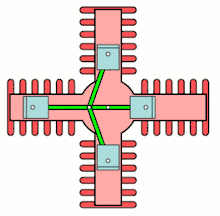X engine


An X engine is a piston engine comprising twinned V-block engines horizontally opposed to each other. Thus, the cylinders are arranged in four banks, driving a common crankshaft. Viewed head-on, this would appear as an X. X engines were often coupled engines derived from existing powerplants.
This configuration is extremely uncommon, primarily due its weight and complexity as compared to a radial engine. It was more compact (per number of cylinders) than a V-engine, however. Shorter crankshafts relative to an inline or V design also appealed to early 20th-century engineers like Henry Ford, given the less developed metallurgical technology of the time.[2]
Most examples of X engines are from the World War II era, and were designed for large military aircraft. The majority of these are X-24s based on existing V-12s. The following are examples of this engine type:
- Ford, as an X-8 prototype during the 1920s that led the way to the company's eventual Flathead V-8.[3][4]
- Daimler-Benz DB 604, developed for the Luftwaffe's Bomber B program. Development suspended.
- Isotta Fraschini Zeta R.C. 24/60, developed for the Caproni Vizzola F.6Z fighter, but never fully completed before Italy's surrender in 1943.
- Rolls-Royce Vulture, based on two Peregrines and the powerplant of the ill-fated Avro Manchester bomber and the Hawker Tornado fighter.
- Rolls-Royce Exe, an air-cooled sleeve valve prototype engine.
- Napier Cub, a water-cooled X-16 engine of the 1920s, which powered the prototype Blackburn Cubaroo torpedo bomber.
- Honda is said to have experimented with an X-32 engine configuration in the 1960s for their Formula One racing efforts, but abandoned the design as being too complex and unreliable.
- Chelyabinsk Tractor Plant T-14 X12 engine 12Н360[5]
More recently, Bradley Howell-Smith's Revetec X4V1 and X4V2 controlled combustion engine designs have used the X configuration to balance the forces created by the axial motions of the cylinder pairs and trilobate cams.
References
- ↑ https://www.google.co.in/patents/US1889583
- ↑ "Henry Ford's Weird Old Engines", Popular Science, pp. 64–67, August 1960
- ↑ Hemmings.com. "Hemmings Auto Blogs » Blog Archive » SIA Flashback - Experimental Ford Engines". Blog.hemmings.com. Retrieved 2011-12-06.
- ↑ "Eli Apolzon and daughter Ruth Family Page * * * Austin, Texas - Henry Ford's X-8 engine and how it will be used to raise dollars for Autistic and other Special Needs children". Lutheransonline.com. 2011-05-10. Retrieved 2011-12-06.
- ↑ http://chtz-uraltrac.ru/catalog/items/206.php
External links
| Wikimedia Commons has media related to X engines. |